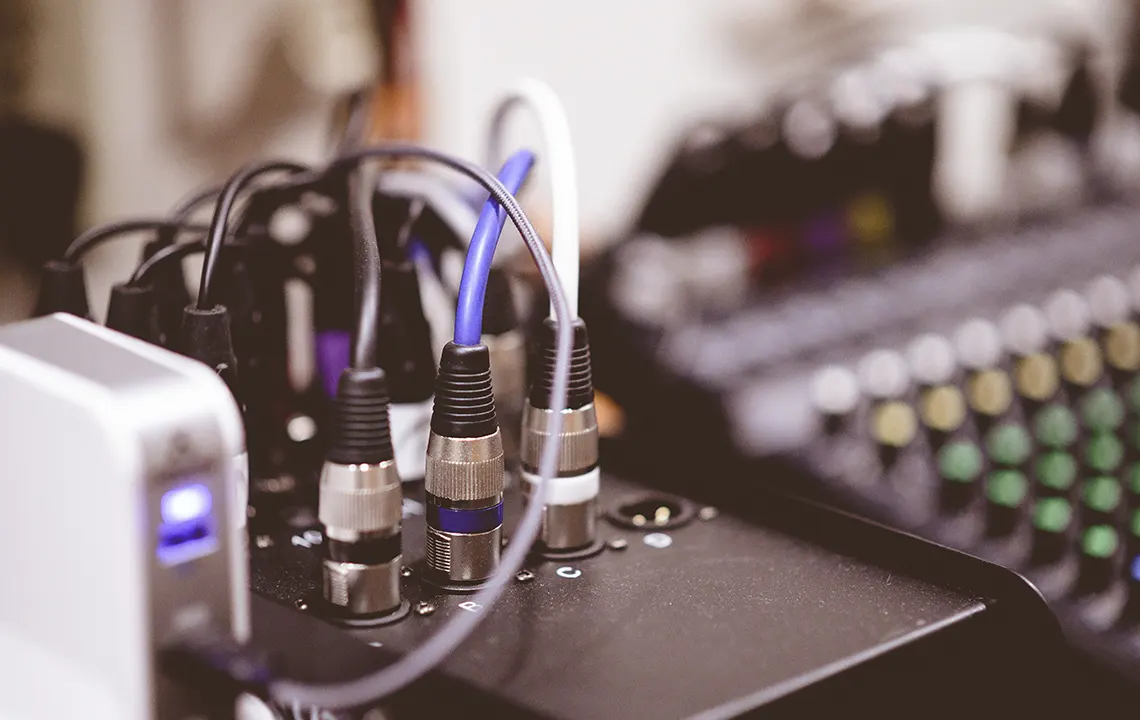Setting up audio equipment might sound intimidating at first—cables everywhere, speakers that look like they could power a stadium, and mysterious buttons on mixers. But here’s the good news: with the right guidance, anyone can create a professional-quality audio setup. Whether you’re hosting a small corporate meeting, a wedding reception, or a full-scale live performance, understanding the basics of audio setup is the key to delivering crystal-clear sound.
At Megahertz Productions, we’ve spent years helping clients bring their events to life through flawless sound and seamless AV setups. In this guide, we’ll break down the fundamentals of audio equipment setup for beginners — no jargon, no confusion, just practical steps and insider tips from real production experts.
Understanding the Basics of Audio Systems
Before we dive into cables and gear, it’s important to understand what an audio system actually does. Every sound setup, no matter how large or small, has three essential components:
- Input: The source of the sound (microphones, instruments, playback devices, etc.)
- Processing: The stage where sound is shaped and controlled (mixers, equalizers, or audio interfaces)
- Output: Where the sound is delivered to the audience (speakers, monitors, headphones)
Once you grasp this simple flow—input → process → output—setting up audio gear becomes far less complicated.
Choosing the Right Audio Equipment
1. Microphones – The Sound Source
Not all microphones are created equal. Choosing the right one depends on what you’re recording or amplifying.
- Dynamic Microphones: Great for live performances, vocals, and instruments. They’re durable and handle loud sounds well.
- Condenser Microphones: Ideal for studio use or quieter environments. They capture more detail but can be sensitive to background noise.
- Lavalier or Wireless Mics: Perfect for presenters and speakers who need freedom to move.
2. Mixers – The Control Center
The mixer is the heart of your audio system. It allows you to control volume levels, EQ (tone), and effects for each input channel.
For beginners, a digital mixer can be a smart investment because it simplifies routing and offers built-in processing tools. However, an analog mixer provides a more hands-on experience and is great for learning signal flow.
3. Speakers and Amplifiers – Delivering the Sound
Speakers turn electrical signals into sound waves that your audience hears.
- Active Speakers: Have built-in amplifiers, making setup easier and cleaner.
- Passive Speakers: Require an external amplifier but often deliver higher output power.
For small events, two active speakers and a subwoofer are often enough. For larger venues, you’ll need to consider PA systems with multiple speakers and amplifiers to ensure even sound coverage.
4. Cables and Connectors – The Unsung Heroes
Good-quality cables make a huge difference. Use XLR cables for microphones and TRS or RCA cables for other connections. Keep cables organized and labeled to avoid confusion during setup.
Always test cables before your event—nothing disrupts an event faster than a faulty wire.
How to Set Up Audio Equipment Step-by-Step
Setting up your gear doesn’t have to be chaotic. Follow this simple, beginner-friendly sequence to ensure a clean, efficient setup every time.
Step 1: Plan Your Layout
Before plugging anything in, decide where each component should go:
- Position speakers in a way that covers the audience evenly.
- Place the mixer in a central, easily accessible spot.
- Keep microphones close to speakers but avoid feedback loops.
Pro tip: Sketch a quick layout on paper—it saves a ton of troubleshooting later.
Step 2: Connect Input Devices
Start with your microphones, instruments, or playback sources. Plug each one into the mixer’s input channels. Label them if possible (e.g., “Vocal,” “Guitar,” “Laptop Audio”). This small step keeps your setup organized and professional.
Step 3: Link Mixer to Speakers
Next, connect the mixer’s main output to your speakers or amplifiers. Make sure you’re using the right cables and that all connections are secure.
If your speakers are powered, plug them directly into the mixer’s output. If they’re passive, route the signal through your amplifier first.
Step 4: Power Up Safely
Turn on equipment in this order:
- Mixer
- Amplifiers or speakers
- Microphones and other input devices
When shutting down, reverse the order. This prevents sudden pops or loud noises that could damage your gear.
Step 5: Sound Check and Adjustments
Once everything is connected and powered, perform a sound check:
- Test each microphone individually.
- Adjust gain and EQ levels.
- Walk around the room to ensure consistent sound coverage.
Avoiding Common Audio Setup Mistakes
Even seasoned professionals can make mistakes under pressure. Here are some of the most common pitfalls beginners should avoid:
Feedback Loops
That ear-piercing screech during an event? It’s usually caused by microphone feedback. Keep mics behind speakers and reduce the gain if feedback occurs.
Unbalanced Sound Levels
If one speaker sounds louder than the other, check your mixer’s pan and volume settings. Always use headphones to monitor balance before the event starts.
Ignoring Room Acoustics
Every room interacts with sound differently. Hard surfaces reflect sound, while carpets absorb it. Use EQ adjustments and speaker placement to balance these effects.
Last-Minute Setup
Rushing is the enemy of good sound. Arrive early, allow time for testing, and have a backup plan for every key component.
Tips for Getting Professional-Quality Sound
You don’t need to be a sound engineer to achieve professional results. Follow these practical tips to elevate your audio setup:
1. Invest in Quality Gear
Cheap equipment might save money upfront but often causes reliability issues during live events. High-quality gear lasts longer, sounds better, and creates a smoother experience for your audience.
2. Keep Cables Tidy
Use cable ties and labels to keep your setup clean. A tidy setup not only looks professional but also makes troubleshooting easier.
3. Learn Basic EQ Techniques
Understanding how to adjust bass, mid, and treble frequencies can dramatically improve your sound quality.
For example, slightly reducing low frequencies on microphones can reduce “boomy” sounds.
4. Record and Review Your Sound
Recording your event or rehearsal is one of the best ways to learn. Play it back, identify weak points, and adjust for next time.
5. When in Doubt, Rent from the Pros
If you’re unsure about what you need—or just want to make sure your event runs perfectly—renting audio equipment from professionals can save you time, money, and stress.
Megahertz Productions offers a full range of audio rentals, livestreaming, and event production services, ensuring your setup is handled by experts from start to finish.
The Importance of Proper Audio Setup in Events
A great event isn’t just about visuals—it’s about how your audience feels. Clear, powerful, well-balanced sound transforms an event from “good” to “unforgettable.” Whether it’s a business conference, a live concert, or a product launch, professional audio makes your message resonate—literally.
At Megahertz Productions, we’ve seen how poor audio can ruin even the most beautiful venues. That’s why our team focuses on precision, planning, and testing for every setup. When your sound is flawless, everything else simply clicks.
When to Hire a Professional AV Company
If you’re hosting a large-scale event, hybrid conference, or live broadcast, professional help is worth every penny.
Here’s when you should call in the experts:
- You have multiple microphones, speakers, and sources.
- You’re livestreaming or recording.
- You need synchronized audio and video playback.
- You want peace of mind knowing professionals are monitoring your sound.
Working with Megahertz Productions means you’ll have a dedicated team managing everything—from pre-event setup to real-time sound mixing—so you can focus on your event instead of the tech.
Final Thoughts
Audio setup may seem like a technical art, but at its heart, it’s about creating connection—making sure every word, note, and moment reaches your audience clearly. With patience, the right equipment, and a little practice, anyone can master the basics of sound setup.
And remember, if you ever need help bringing your audio vision to life, Megahertz Productions is here to make it sound perfect.



